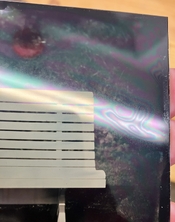You are using an out of date browser. It may not display this or other websites correctly.
You should upgrade or use an alternative browser.
You should upgrade or use an alternative browser.
Markings on tintypes?
-
A
- Thread starter -chrille-
- Start date
Recent Classifieds
-
Want to Buy Bronica ETR system 135W pano film back
- Started by subtlelikeatrex
-
Want to Buy Bronica ETR System Film Back Shell
- Started by subtlelikeatrex
-
For Sale Two Unicolor C41 Kits
- Started by davela
-
For Sale Zeikos Four Piece Close-Up Set for 62mm - Film or Digital - New
- Started by davela
-
For Sale Nikon HK-8 Lens Hood
- Started by davela
Forum statistics
I think it has something to do with the paint layer on the black plates you're using. You could try applying a coating on top of that (perhaps just black paint, or a clear varnish), then pour collodion over that. See if the same iridescence still emerges.
retina_restoration
Member
I agree. I used to see this on “trophy plate” aluminum, and mostly on certain brands. I don’t use trophy plate anymore because of its many flaws.I think it has something to do with the paint layer on the black plates you're using.
Ian C
Member
- Joined
- Feb 8, 2009
- Messages
- 1,277
- Format
- Large Format
It is the phenomenon of Thin Film Interference. This is often seen when a thin layer of gasoline lies atop water, such as when a drop of gasoline drips onto calm water while fueling an outboard motor on a small boat alongside a dock.
It’s also seen just after a light rain when the thinner components of motor oil float on wet asphalt.
It doesn’t require oil. Many thin transparent materials will produce this effect.
https://www.google.com/search?q=thi...MuNLgH5QXCBwkwLjIuMC4zLjLIB1c&sclient=gws-wiz
It is the basis of antireflection coatings applied to filters and lenses.
https://en.wikipedia.org/wiki/Thin-film_interference
It’s also seen just after a light rain when the thinner components of motor oil float on wet asphalt.
It doesn’t require oil. Many thin transparent materials will produce this effect.
https://www.google.com/search?q=thi...MuNLgH5QXCBwkwLjIuMC4zLjLIB1c&sclient=gws-wiz
It is the basis of antireflection coatings applied to filters and lenses.
https://en.wikipedia.org/wiki/Thin-film_interference
Last edited:
The optics behind Newton rings are similar, the cause and solution tend to be different. In a very general sense, you could group them all under 'interference caused in the interface of two layers' - but that doesn't get you very far in solving the issue, I suppose.
| Photrio.com contains affiliate links to products. We may receive a commission for purchases made through these links. To read our full affiliate disclosure statement please click Here. |
PHOTRIO PARTNERS EQUALLY FUNDING OUR COMMUNITY:  |


